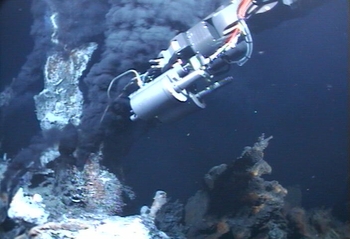Water Sampling
Sampling ocean, seep, and hot-spring fluids in the deep sea
During this expedition, as the R/V Thompson transits from near shore to blue water environments, we will be sampling at depths of <500 to >2500 m to investigate the chemistry of ocean water. Specific sites include those off Grays Harbor, Washington, Newport, Oregon, Hydrate Ridge, and Axial Seamount. Fluid samples will be obtained using niskin bottles on a rosette on a conductivity-temperature-depth (CTD) frame. These samples will be filtered to study microorganisms (archaea and bacteria) in different marine environments. Fluids will also be analyzed using a shipboard in situ flow cytometer that allows analyses and rapid sorting of individual organisms. The Thompson is the only ship in the UNOLS fleet that currently hosts this capability.
Hydrate Ridge: Methane-rich fluids at Hydrate Ridge will be sampled using titanium "syringes" and niskin bottles with the robotic vehicle Jason. Here, the methane-rich fluids with less sulfide support dense mats of chemosynthetic microbial communities. Bacterial communities include sulfate-reducing bacteria and methanogens. Methane-rich fluids also support communities of very large clams. Methane issuing from the seafloor forms distinct plumes in the water column above the gas hydrate deposits and these fluids will be sampled using the CTD.
Axial Volcano: This large volcano hosts multiple, active hydrothermal fields with numerous anhydrite-, barite- and sulfide-rich chimneys. Fluids issuing from the vents are very enriched in magmatic gases such as carbon dioxide, reflecting the presence of molten basalt beneath the volcano. Titanium syringes will also be used to sample the 300°C hydrothermal fluids, in a similar fashion to sampling techniques used at Hydrate Ridge. In the past, numerous vents issued fluids that were boiling, but more recent studies by NOAA-PMEL investigators show that boiling activity has decreased. Shore-based chemical analyses will be completed on the fluids, as well as investigation of microorganisms that thrive in this extreme environment.


